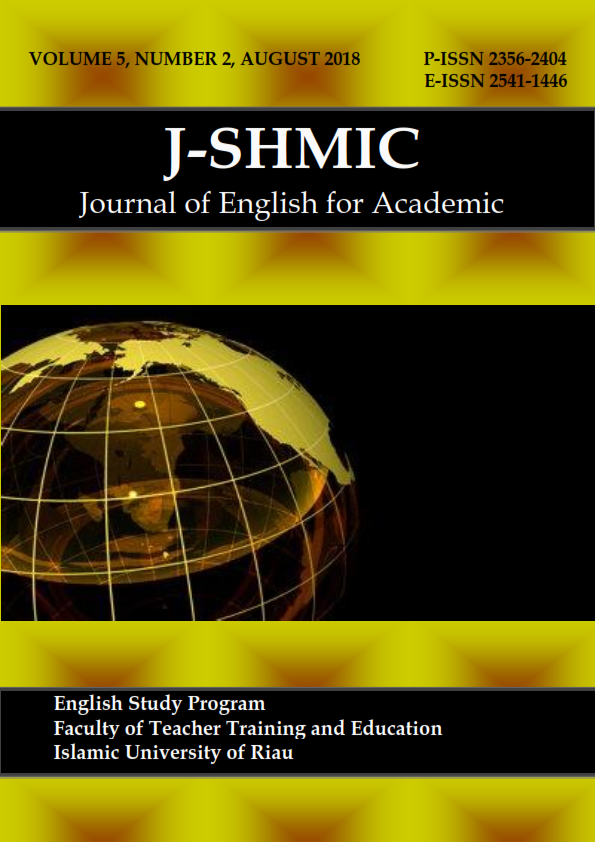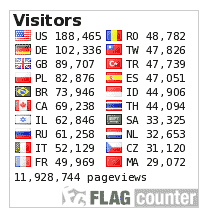The Effect of Blended Learning Model towards Students’ Writing Ability
Keywords:
Blended Learning Model, Telegram Messenger, Writing AbilityAbstract
The rapid development of science and technology in the current era of globalization brings many changes in various aspects of social life. These changes include education. Recognizing this, Indonesia has published English as one of the crucial subject. However, students got some difficulties in writing. To assist students in solving writing problem, this study was conducted to know the effect of blended learning model towards students’ writing ability of the eleventh grade students at SMAN 6 Pekanbaru. Sample of the study was determined through random sampling method. There were 10 classes randomly selected. It consisted of two classes that were XI IPA 1 as experimental class and XI IPA 2 as control class. Afterwards, the experimental group was taught by applying blended learning model through Telegram Messenger and the control group was instructed through the traditional method by lecturing method. To gain data, writing test was administered. After collecting data, the mean scores of the pre-test and the post-test for the two groups were calculated using the t-test. Findings of the study revealed that there were statistically significant differences between the means of two groups in favor of the experimental group which achieved better results in the post-test. It was proved by the significant level of 0.05 which was t=3.983 and p=0.000. On the other hand, there is a significant effect of blended learning model towards students’ writing ability.
Downloads
References
Al-haq, F. A., & Al-sobh, M. A. (2010). The effect of a web-based writing instructional EFL program on enhancing the performance of Jordanian secondary students. Jaltcalljournal, 6(3), 189–218.
Al-Jarf, R. (2004). The Effect of Web-based Learning on Struggling EFL College Writers. Foreign Language Annals 37(1).
Al-Masry, N. M. S. (2012). The Effectiveness of Using Blended Learning in Teaching a unit in English Language in Second Secondary Class in Mecca. (Unpublished Master Degree). Faculty of Education, Om El-Qura University, Mecca.
Asnawi, A. (2017). Pemanfaatan Blended Learning Edmodo Grup dalam Pempelajaran Mata Kuliah Membaca. GERAM, 5(2), 53-61. Retrieved from http://journal.uir.ac.id/index.php/geram/article/view/984
Azizan, F.Z. (2010). Blended Learning in Higher Education Institution in Malaysia. Proceedings of Regional Conference on Knowledge Integration in ICT.
Bataineh, A. (2010). The Effect of the Internet on Improving Foreign Language Students' writing Performance. An-Najah Univ. J. of Res. (Humanities), 24(4).
Brown, H. D. (2001). Teaching by Principles an Interactive Approach to Language Pedagogy. San Francisco: Longman.
Carman, J. M. (2005). Blended Learning Design : Five Key Ingredients. Blended Learning Design: 5 Key Ingredients, (August), 1–10. https://doi.org/10.1109/CSSE.2008.198
Chen, C.C., & Jones, K.T. (2007). “Blended Learning vs. Traditional Classroom Settings: Assessing Effectiveness and Student Perceptions in an MBA Accounting Course”. The Journal of Educators Online, 4 (1).
Cole, J., & Feng, J. (2015). Effective strategies for improving writing skills of elementary English language learners. Chinese American Educational Research and Development Association Annual Conference, (April), 1–25. Retrieved from https://files.eric.ed.gov/fulltext/ED556123.pdf
Creswell, J. W. (2013). Research Design: Qualitative, Quantitative, and Mixed Methods Approaches. Research design Qualitative quantitative and mixed methods approaches. https://doi.org/10.1007/s13398-014-0173-7.2
Davis, H.C. & Fill, K. (2007). “Embedding blended learning in a university’s teaching culture: Experiences and reflections”. British Journal of Educational Technology, 38 (5).
Ebeedat, Th., Adas A. & Abel-Haq K. (2005). "Scientific Research, concept, techniques and tools." Amman, Jordan: Dar Alfeker.
Ellis, R., Goodyear, P., Prosser, M., & O’Hara, A. (2006). How and what university students learn through online and face-to-face discussions: conceptions, intentions and approaches. Journal of Computer Assisted Learning.
Hameed, Sh., Badii, A., & Cullen, A.J. (2008). “Effective E-Learning Integration with Traditional Learning in a Blended Learning Environment”. European and Mediterranean Conference on Information Systems.
Horn, M. B., & Staker, H. (2014). Models of blended learning. Blended: Using Disruptive Innovation to Improve Schools, 6–9. Retrieved from http://www.blendedlearning.org/wp-content/uploads/2014/11/1-Models-of-Blended-Learning.pdf
Husamah. (2014). Pembelajaran Bauran (Blended Learning): Terampil Memadukan Keunggulan Pembelajaran Face-To-Face, E-Learning Offline-Online, dan Mobile Learning. Jakarta: Prestasi Pustaka.
Jia J., Chen Y., Ding Z., & Ruan M. (2012). Effects of a vocabulary acquisition and assessment system on students‟ performance in a blended learning class for English subject. Computers & Education, 58 (1): 63-76.
Jia, J., Chen, Y., Ding, Z., & Ruan, M. (2012). Effects of a Vocabulary Acquisition and Assessment System on Students’ Performance in a Blended Learning Class for English Subject. Computers & Education, 58(1), 63–76. Retrieved from https://www.learntechlib.org/p/50715
Julian, E. (1993). Essentials Of English Language Teaching. New York: Longman Published.
Kaoud, A. A. E. (2007). The Effectiveness of Internet Blended Discussion Group on Developing Some Composition Writing Skills of First Year Secondary School Students. Retrieved from http://srv3.eulc.edu.eg/eulc_v5/libraries/start.aspx.
Kocoglu, Z., Ozek, Y. and Kesli, Y. (2011). Blended learning: Investigating its potential in an English language teacher training program. Australasian Journal of Educational Technology, 27(7): 1124-1134.
Köse, U. (2010). A blended learning model supported with Web 2.0 technologies. In Procedia - Social and Behavioral Sciences (Vol. 2, pp. 2794–2802). https://doi.org/10.1016/j.sbspro.2010.03.417
Norberg, A., Dziuban, C. D., & Moskal, P. D. (2011). A time‐based blended learning model. On the Horizon, 19(3), 207–216. https://doi.org/10.1108/10748121111163913
Oh, E., & Park, S. (2009). “How are universities involved in blended instruction?” Educational Technology & Society, 12 (3).
Oshima, A., & Hogue, A. (2007). Introduction to Academic Writing. White plains, New York: Pearson: Longman.
Pazio Monika (2010). Blended learning and its potential in expanding vocabulary knowledge: A case study. Teaching English with Technology, 10(1): 3-30.
Richard, J. C. & Renandya, W. A. (2002). Methodology in Language Teaching: An Anthology of Current Practices. New York: Cambridge University Press.
Saade, R.G. and Kira, D. (2009). Computer anxiety ine-learning: The effect of computer self-efficacy. Journal of Information Technology Education (8): 177-190.
Sayed, E.. A. A. (2012). The Effect of Using Electronic Portfolios on Developing the English Language Writing Skills for Second Grade Preparatory School Students. Retrieved from http://srv3.eulc.edu.eg/eulc_v5/libraries/start.aspx.
Shih, R. (2011). Can Web 2.0 technology assist college students in learning English writing? Integrating Face book and peer assessment with blended learning. Australasian Journal of Educational Technology, 27(5): 829-845.
Shih, Ru-Chu (2010). Blended learning using video-based blogs: Public speaking for English as second language students. Australasian Journal of Educational Technology2010, 26(6): 883-897.
So, H.-J., & Brush, T. A. (2008). Student perceptions of collaborative learning, social presence and satisfaction in a blended learning environment: Relationships and critical factors. Computers & Education, 51(1), 318–336. https://doi.org/10.1016/j.compedu.2007.05.009
Sutanto, L. (2013). Kiat Jitu Menulis Skripsi, Tesis, dan Disertasi. Jakarta: Erlangga.
Tarigan, H., G. (2008). Menulis Sebagai Suatu Keterampilan berbahasa. Bandung: Angkasa bandung.
Wahyuni, S. (2017). Students’ Ability in Writing Hortatory Exposition of Eleventh Grade Students at SMAN 14 Pekanbaru. Journal of English for Academic, 4(2), 87–93. Retrieved from http://journal.uir.ac.id/index.php/jshmic/article/view/537
Wahyuni, S. (2018). Students’ Perspectives on Using Telegram Messenger as A Learning Media. ELT-Lectura Journal, 5(1), 31-37. Retrieved from https://journal.unilak.ac.id/index.php/ELT-Lectura/article/view/1073
Yuen, A.H.K. (2010). “Blended learning in Higher Education: An Exploration of Teaching Approaches”. Proceedings of the 18th International Conference on Computers in Education.
Zahari, M. (2011). Menjunjung Bahasa Persatuan. Jakarta: Gria Media Prima.
Zhang T. (2007). Using Online Discussion Forums to Assist Traditional English Class. International Journal on E-Learning (IJEL) 6(4). Retrieved from http://www.editlib.org/p/38860/
Published
How to Cite
Issue
Section
This is an open-access article distributed under the terms of the Creative Commons Attribution-ShareAlike 4.0 International License which permits unrestricted use, distribution, and reproduction in any medium. Users are allowed to read, download, copy, distribute, search, or link to full-text articles in this journal without asking by giving appropriate credit, providing a link to the license, and indicating if changes were made. All of the remixes, transform, or build upon the material must distribute the contributions under the same license as the original.











